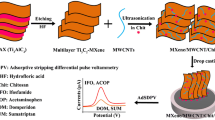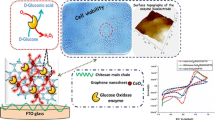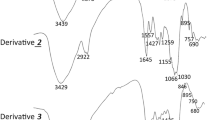Abstract
This study formulates biocomposites of chitosan, multi-walled carbon nanotubes (MWCNTs), iron oxide, and titanium oxide, characterizes their physical properties, and evaluates their antibacterial and biosensor toward digoxin detection. SEM was used to investigate morphology, whereas FTIR analysis peaks of active compounds of chitosan, MWCNTs, and composites were observed. The composites demonstrate strong antibacterial effects having ZOI 25, 12 mm; 35, 3 mm; and 43, 12 mm using M-chitosan, M-chitosan-TiO2, M-chitosan-Fe3O4 against S. aureus and A. baumannii, respectively. The composites were deposited on GCSPE to detect serum digoxin using CV. The biosensor can detect digoxin in the range 0–50 fM and 0–100 fM, with a detection limit of 0.8 pM and 0.03 pM for M-chitosan-TiO2 and M-chitosan-Fe3O4. The prepared biosensor showed strong specific recognition properties, ease, affordability of preparation, sensitive, and enable routine clinical analysis to identify trace amounts of digoxin. Thus, the present study developed composites with improved functional properties.
Graphical abstract








Similar content being viewed by others
Data availability
Data analyzed during the current study are available in the supplementary information.
References
D. Bharathi, R. Rajamani, B.Z. Sibuh, S. Pandit, S. Agrawal, N. Mishra, P.K. Gupta, Biogenic preparation, characterization, and biomedical applications of chitosan functionalized iron oxide nanocomposite. J. Compos. Sci. 6(5), 120 (2022)
H.M. Abdel-Mageed, N.Z. AbuelEzz, R.A. Radwan, S.A. Mohamed, Nanoparticles in nanomedicine: a comprehensive updated review on current status, challenges and emerging opportunities. J. Microencapsul. 38(6), 414–436 (2021)
M.A. Sadique, S. Yadav, V. Khare, R. Khan, G.K. Tripathi, P.S. Khare, Functionalized titanium dioxide nanoparticle-based electrochemical immunosensor for detection of SARS-CoV-2 antibody. Diagnostics 12(11), 2612 (2022)
D. Franco, G. Calabrese, S.P.P. Guglielmino, S. Conoci, Metal-based nanoparticles: antibacterial mechanisms and biomedical application. Microorganisms 10(9), 1778 (2022)
N.A. Zakariya, W.H.W. Jusof, S. Majeed, Green approach for iron oxide nanoparticles synthesis: application in antimicrobial and anticancer-an updated review. Karbala Int. J. Modern Sci. 8(3), 421–437 (2022)
R. Sokary, Abu el-naga, M. N., Bekhit, M., & Atta, S., A potential antibiofilm, antimicrobial and anticancer activities of chitosan capped gold nanoparticles prepared by γ–irradiation. Mater. Technol. 37(7), 493–502 (2022)
K. Chetankumar, B.K. Swamy, H.B. Naik, MgO and MWCNTs amplified electrochemical sensor for guanine, adenine and epinephrine. Mater. Chem. Phys. 267, 124610 (2021)
K. Rovina, S. Siddiquee, S. MdShaarani, An electrochemical sensor for the determination of tartrazine based on CHIT/GO/MWCNTs/AuNPs composite film modified glassy carbon electrode. Drug Chem. Toxicol. 44(5), 447–457 (2021)
S. Pitiphattharabun, K. Meesombad, G. Panomsuwan, O. Jongprateep, MWCNT/Ti-doped ZnO nanocomposite as electrochemical sensor for detecting glutamate and ascorbic acid. Int. J. Appl. Ceram. Technol. 19(1), 467–479 (2022)
A. Alangari, M.S. Alqahtani, A. Mateen, M.A. Kalam, A. Alshememry, R. Ali, R. Syed, Iron oxide nanoparticles: preparation, characterization, and assessment of antimicrobial and anticancer activity. Adsorpt. Sci. Technol. 2022, 1–9 (2022)
M. Al-Salih, S. Samsudin, S.S. Arshad, Synthesis and characterizations iron oxide carbon nanotubes nanocomposite by laser ablation for anti-microbial applications. J. Genet. Eng. Biotechnol. 19(1), 76 (2021)
N. Zafar, B. Uzair, M.B.K. Niazi, S. Sajjad, G. Samin, M.J. Arshed, S. Rafiq, Fabrication & characterization of chitosan coated biologically synthesized TiO2 nanoparticles against PDR E. coli of veterinary origin. Adv. Polym. Technol. 2020, 1–13 (2020)
K.A. Sukkar, S.A. Duha, A.A. Hussein, R.M. Mohammad, Synthesis and characterization hybrid materials (TiO2/MWCNTS) by chemical method and evaluating antibacterial activity against common microbial pathogens. Acta Phys. Pol. A 135(4), 588–592 (2019)
A.A.H. Bukhari, Preparation, Characterization and anti-bacterial activity of chitosan/carbon nanotube nanocomposites. Indian J. Sci. Technol. 12, 15 (2019)
R.R. Parikh, K.R. Patel, J.V. Pergolizzi Jr., F. Breve, P. Magnusson, Effects of digoxin in heart failure (HF) with reduced ejection fraction (EF). Cureus (2022). https://doi.org/10.7759/cureus.22778
V. Eslami, F. Mortezapour, S. Samavat, S. Ziae, A. Gheymati, Evaluating plasma Digoxin concentration after an intravenous loading dose in patients with renal failure. Arch. Clin. Nephrol. 7(1), 033–037 (2021)
Y. He, Y. Zheng, Determination of digoxin glycoside in foxglove flower using Ag2S/CNTs nanocomposites. Int. J. Electrochem. Sci 17(221126), 2 (2022)
A. Ahmadi, H. Shirazi, N. Pourbagher, A. Akbarzadeh, K. Omidfar, An electrochemical immunosensor for digoxin using core–shell gold coated magnetic nanoparticles as labels. Mol. Biol. Rep. 41, 1659–1668 (2014)
S.I. Khan, R.R. Chillawar, K.K. Tadi, R.V. Motghare, Molecular imprinted polymer based impedimetric sensor for trace level determination of digoxin in biological and pharmaceutical samples. Curr. Anal. Chem. 14(5), 474–482 (2018)
B. Tserengombo, H. Jeong, E. Dolgor, A. Delgado, S. Kim, Effects of functionalization in different conditions and ball milling on the dispersion and thermal and electrical conductivity of MWCNTs in aqueous solution. Nanomaterials 11(5), 1323 (2021)
M.A. Salam, R. Burk, Synthesis and characterization of multi-walled carbon nanotubes modified with octadecylamine and polyethylene glycol. Arab. J. Chem. 10, S921–S927 (2017)
H. Soleimani, N. Yahya, M. Baig, L. Khodapanah, M. Sabet, M. Burda, M. Awang, Synthesis of carbon nanotubes for oil-water interfacial tension reduction. Oil Gas Res. 1(1), 1000104 (2015)
M. Eddya, B. Tbib, E.H. Khalil, A comparison of chitosan properties after extraction from shrimp shells by diluted and concentrated acids. Heliyon 6(2), e03486 (2020)
S.H. Lim, S.M. Hudson, Synthesis and antimicrobial activity of a water-soluble chitosan derivative with a fiber-reactive group. Carbohyd. Res. 339(2), 313–319 (2004)
R. Varma, S. Vasudevan, Extraction, characterization, and antimicrobial activity of chitosan from horse mussel modiolus modiolus. ACS Omega 5(32), 20224–20230 (2020)
S.S.E. Bakhtiari, S. Karbasi, S.A.H. Tabrizi, R. Ebrahimi-Kahrizsangi, Chitosan/MWCNTs composite as bone substitute: Physical, mechanical, bioactivity, and biodegradation evaluation. Polym. Compos. 40(S2), E1622–E1632 (2019)
B. Lesiak, N. Rangam, P. Jiricek, I. Gordeev, J. Tóth, L. Kövér, P. Borowicz, Surface study of Fe3O4 nanoparticles functionalized with biocompatible adsorbed molecules. Front. Chem. 7, 642 (2019)
S. Das, S. Diyali, G. Vinothini, B. Perumalsamy, G. Balakrishnan, T. Ramasamy, B. Biswas, Synthesis, morphological analysis, antibacterial activity of iron oxide nanoparticles and the cytotoxic effect on lung cancer cell line. Heliyon 6(9), e04953 (2020)
W. Bing, H. Sun, Z. Yan, J. Ren, X. Qu, Programmed bacteria death induced by carbon dots with different surface charge. Small 12(34), 4713–4718 (2016)
D.J. Dwyer, D.M. Camacho, M.A. Kohanski, J.M. Callura, J.J. Collins, Antibiotic-induced bacterial cell death exhibits physiological and biochemical hallmarks of apoptosis. Mol. Cell 46(5), 561–572 (2012)
C. Yang, J. Mamouni, Y. Tang, L. Yang, Antimicrobial activity of single-walled carbon nanotubes: length effect. Langmuir 26(20), 16013–16019 (2010)
D. Asli, O. Tulin, S. Necdet, Investigation of the usage of chitosan as an antimicrobial agent in textile industry. Tekstil ve Konfeksiyon 18, 94–102 (2008)
P. Praveen, G. Viruthagiri, S. Mugundan, N. Shanmugam, Structural, optical and morphological analyses of pristine titanium di-oxide nanoparticles–Synthesized via sol–gel route. Spectrochim. Acta Part A Mol. Biomol. Spectrosc. 117, 622–629 (2014)
U.S. Ezealigo, B.N. Ezealigo, S.O. Aisida, F.I. Ezema, Iron oxide nanoparticles in biological systems: antibacterial and toxicology perspective. JCIS Open 4, 100027 (2021)
J.C. Solís, M. Galicia, High performance of MWCNTs-chitosan modified glassy carbon electrode for voltammetric trace analysis of Cd (II). Int. J. Electrochem. Sci 15, 6815–6828 (2020)
A. Aoboun, B. Cherdhirunkorn, C. Pechyen, Development of screen printed electrode using MWCNTs–TiO 2 nanocomposite as a low-cost device for uric acid detection in urine. J. Mater. Sci.: Mater. Electron. 30, 2403–2412 (2019)
M. Arakha, S. Pal, D. Samantarrai, T.K. Panigrahi, B.C. Mallick, K. Pramanik, S. Jha, Antimicrobial activity of iron oxide nanoparticle upon modulation of nanoparticle-bacteria interface. Sci. Rep. 5(1), 14813 (2015)
W. Buraso, V. Lachom, P. Siriya, P. Laokul, Synthesis of TiO2 nanoparticles via a simple precipitation method and photocatalytic performance. Mater. Res. Exp. 5(11), 115003 (2018)
S. Sam, L. Touahir, J.S. Andresa, P. Allongue, J.N. Chazalviel, A.C. Gouget-Laemmel, C.H. De Villeneuve, A. Moraillon, F. Ozanam, N. Gabouze, S. Djebbar, Semiquantitative study of the EDC/NHS activation of acid terminalgroups at modified porous silicon surfaces. Langmuir 26, 809–814 (2010)
Acknowledgments
The Pakistan Institute of Engineering and Applied Sciences (PIEAS), Islamabad, provided the characterization facilities at the Material Science Laboratory. We also appreciate the cooperation of COMSATS University of Science and Technology in determining the antibacterial properties.
Author information
Authors and Affiliations
Corresponding author
Ethics declarations
Conflict of interest
There are no conflicts of interest declared by the authors.
Additional information
Publisher's Note
Springer Nature remains neutral with regard to jurisdictional claims in published maps and institutional affiliations.
Supplementary Information
Below is the link to the electronic supplementary material.
Rights and permissions
Springer Nature or its licensor (e.g. a society or other partner) holds exclusive rights to this article under a publishing agreement with the author(s) or other rightsholder(s); author self-archiving of the accepted manuscript version of this article is solely governed by the terms of such publishing agreement and applicable law.
About this article
Cite this article
Rafique, S., Akram, R., Hussain, M. et al. A comparative study of antibacterial properties and label-free electrochemical detection of digoxin based on MWCNTs-chitosan-Fe3O4/TiO2 composites. Journal of Materials Research 38, 3199–3213 (2023). https://doi.org/10.1557/s43578-023-01059-w
Received:
Accepted:
Published:
Issue Date:
DOI: https://doi.org/10.1557/s43578-023-01059-w




